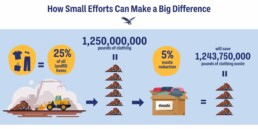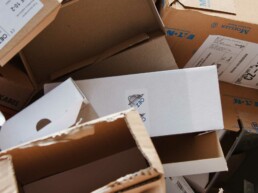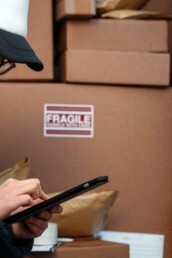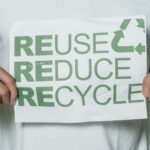The Environmental Impact of Returns
The world has witnessed unprecedented growth in the e-commerce sector. With such transformation, we’ve also witnessed the environmental impact of returns, which has grown larger than most of us realize.
We will be discussing the environmental impact of returns and how your e-commerce business can reduce your carbon footprint by reducing the waste of returned products.
The Rise of Returns
In 2019, the e-commerce sector saw $309 billion in returns. In 2020, $428 billion. With an average return rate of 30% for online purchases and between 8% and 10% for brick and mortar stores, these numbers are only expected to increase as the years continue.
With an influx of e-commerce returns, it’s now customary for more than 60% of shoppers to check return policies before ever considering a purchase. Within the fashion industry, return rates are quickly approaching upwards of 50%.
Why are we seeing these numbers and what do they mean for e-commerce companies, the environment, and your customers?
The Statistics Behind E-commerce Returns
With so many returns happening in almost every sector of e-commerce, it’s difficult to pinpoint where to start making changes and in what ways. If you’re a bit overwhelmed, we’re here to make it a little easier for you.
|
Reason Given |
Verticals with Highest Return |
78% of all returned items were clothing, with 40% of shoppers admitting they bought multiple items with the intent to return all but one.
Statistics tell part of the story but, let’s dive into the environmental impact of returns and what happens to them once they leave the customer.
The Reality of E-commerce Returns
With a quarter of all consumers returning between 5% and 15% of all online purchases, we’re looking at around 5 billion pounds of returned product. Every…single…year.
So, what happens to e-commerce returns? Where do they go?
Well, as great as it would be to assume companies simply re-sell used and unused returned items, that is not the reality. Less than 48% of all returned items are able to be re-sold at full price.
For most companies, the process of re-selling returned items is oftentimes more expensive than simply trashing or burning returned products.
Learn how your e-commerce can start avoiding returns altogether.
Early last year, an Amazon warehouse in the UK was said to destroy 130,000 returned items that were in “good condition” every single week.
For the fashion industry (which is currently ranking highest in returned items), the re-sell rate is much lower. This is because the fashion industry is infamous for its destruction of returned items.
Famous brands like H&M and Burberry have openly admitted to burning millions of dollars worth of returned products each year. Why? Re-selling clothing especially those associated with “luxury brands”, at a cheaper “used” price, would decrease the overall “value” and “reputation” of said brands.
For example, Louis Vuitton burns every returned item in order to remain “scarce”, “desirable”, and “luxurious”. If you could pick up a used Louis Vuitton bag for $40 at Goodwill, suddenly waiting for that deal is more enticing than saving up and purchasing directly from the luxury brand itself.

Given this fact, what happens to the millions of articles of clothing that are returned every year? The answer is simple – it heads straight for landfills.
What happens at landfills? We’ll walk you through it.
Behind the Scenes of a Landfill
Step 1. Once a customer decides to return an item, there are several ways it ends up at a landfill. Sometimes, returned items skip all processes and head straight for a landfill. Other times, items are unnecessarily shipped around the world before ultimately ending up at a landfill.
Step 2. Returned items, along with millions of tons of everyday trash, are tightly packed under a heavy layer of dirt and lined with a layer of rubber and clay. Landfills are not meant to decompose trash, but rather to secure it as more and more is added, buried, and lined every day.
Step 3. Regardless, trash decomposes. Once the layers of trash begin to decompose, a toxic liquid known as leachate begins to form. A lack of oxygen within the layers of decomposing trash causes bacteria to slowly produce methane gas that rises through the artificial barriers – right into our atmosphere.
Step 4. In addition to the enormous amounts of methane being produced and released into our skies, the leachate begins to slowly leak out of the rubber and clay liners. Some of it is reclaimed, treated, and re-used as irrigation, or sometimes drinking water. The unclaimed leachate begins to produce ammonia and mercury, dead-zoning nearby ecosystems.

The Environmental Impact of Returns
Now that you know how landfills operate, let’s consider their overall impact and how much of a difference that one return is really making.
Third Largest Source of Methane Emissions
With agriculture and electricity coming in first and second place for the largest production of human-produced methane, landfills take third place. What quantifies a third-place position? Third-place consists of 5 billion pounds of landfill waste and 15 million metric tons of carbon emissions – every year.
This is the equivalent to the emissions of 3 million cars in one year.
On top of this number, the rate of carbon emissions is expected to increase 30% by 2030.
That’s 3,900,000 cars.

Biodiversity
The average landfill takes up 600 acres. That’s just shy of an entire mile of decomposing garbage.
This contributes to the loss of approximately 20 to 300 species per 100 acres. Animals feed on waste, then transfer toxins to subsequent species that feed on them.
The cycle percolates all the way down to invasive plant species and surrounding soil fertility.
Human Health
According to a study done by the International Journal of Epidemiology, for families living within 3.1 miles of a landfill, there was a strong correlation between Hydrogen Sulphide (a colorless, highly poisonous, flammable, and corrosive gas produced by rapidly decaying organic matter) and deaths caused by lung cancer and respiratory problems – especially in children.
Families living within one mile of a landfill have a 12% increased risk of congenital malformations in their children.
If that isn’t enough, consider drinking leachate (the liquid that leaks out of landfills). Why? Some of us already are.
In 2008, California approved the operation of the Advanced Water Purification Facility. It produces 70 million gallons of drinking water from sewage, every day.
This purified wastewater then supplies about 10% of the water demand for California’s 2.3 million residents.

Economic Effects
Because of the rising trend for purchasing multiple items with the intent to return all but one, companies are now over-producing for misleading demand. This contributes to a 10% loss of global sales and $11.4 billion dollars of possible revenue that’s buried in the dirt every single year.
How to Reduce the Environmental Impact of Returns
Our goal is to help e-commerce companies reduce their overall carbon footprint and motivate shoppers to do the same. Below are a few ways your e-commerce brand can minimize the environmental impact and also that of your customers.
Return Policy
Updating and clarifying your return policy is key when it comes to reducing overall returns. By making return policies prominent, easily accessible, and simple, customers have a higher chance of understanding what they can and cannot do when it comes to returns.

Learn how to create a clear return policy.
Eco-friendly Packaging
Sustainable packaging is big and it’s only going to get bigger. Over half of your customer base is now considering sustainable packaging when choosing a product and whether or not they will shop with a brand.
Greener packaging is a growing favorite amongst consumers, and it’s a simple way to reduce your company’s carbon footprint. Additionally, you can help your customers personally reduce their own carbon footprint by providing reusable packaging or appropriate steps to discard their orders.
If you’d like to learn more about sustainable packaging and how to make the transition for your e-commerce company, check out our guide on sustainable packaging.
Ditch Return Labels
Switch to a return portal instead of providing pre-printed return labels. This not only reduces paper waste but also simplifies customer experience while simultaneously reducing returns.

Once customers decide they want to return an item, using a return portal will help determine if an item is suitable for return and also promotes a longer consideration period for a customer before blindly sending an item back.
Exchange over Refund
If customers are able to purchase multiple items and send them all back for a full refund – what’s the point of selling those items in the first place? Make full or partial refunds harder to come by with stricter return regulations and an emphasis on exchanging.
Limiting full and partial refunds will deter customers from buying items with the sole intent of returning them, and will promote a more thoughtful and considerate shopping experience for customers.
Additionally, clearly communicating why your company is moving away from returns and refunds may help bring the attention of shoppers to the direct impact their shopping habits are having on the current return crisis.
Upcycle and Recycle
Ensuring that returned products are not being destroyed or disposed of is the main goal here.
Consider repurposing returned items that do not qualify for re-sell or donation. For returned items that can’t be re-sold at full price but are still in good condition, consider partnering with a recycling program or donation center to ensure products are being repurposed or indefinitely re-sold and used.
A great example of this is Sheets and Giggle’s sheet donation program. For anyone who donates their used sheets to S&G will receive a 10% off code for their new set of sustainable sheets.
Donated items are then repurposed and skip landfills altogether. Creating a landfill alternative is a way to stand out to customers as an environmentally conscious company.
Re-sell Used Items & Donation
Instead of shipping returned items off to the landfill, incinerator, or selling them to companies to only re-sell them again, just double down and start reselling your own returned, used items.
Patagonia is a great example of utilizing the thrift world. Whenever a used item is returned in good condition, it’s re-sold on their own “used store”.
This allows customers to stay loyal to your brand, reduces the number of items going to landfills, and caters to customers who may not want to pay for brand-new products. Not to mention, your company will be profiting on what would otherwise be considered total losses.
In addition to re-selling used items, donating returned products that cannot be re-sold for a profit will continue to reduce product waste and allow even unsellable items to be used, enjoyed, and saved from contributing to pollution.

Incentivize Greener Shipping & BOPIS
Today, shoppers want their orders and they want them now. However, expedited shipping options play a major role in a negative environmental impact.
Encouraging customers with promotions, codes, and freebies to wait that extra day, pick up items from a physical store, or bundle with more products to save future driving trips, will not only help reduce our overall carbon footprint but will also help customers feel rewarded for participating in cleaner acts.
Anti Fraud Tags
It’s more than normal to buy a dress for a certain occasion and then return it the next day. Unfortunately, this is a bad habit that is only growing in popularity.
Investing in security or anti-fraud tags, such as the 360 ID Tag, will help your business send products to customers without shoppers returning them once they’ve been used. Security tags allow customers to try items on and even wear them around town (although the prominent security tag won’t be very attractive).
However, returnability is strongly affected once the tag is broken or tarnished. This will deter customers from making a purchase without the intent of keeping the item – both online and in-store.
Avoid Returns Altogether
The best way to create green returns for your business is to avoid returns altogether. We understand this is easier said than done, but with a big enough effort and a desire to become better, returns can be exceptionally reduced while still providing customers with a satisfying shopping experience.
To learn more about avoiding returns, check out our blog article where we go over exactly that.
Reduce the Environmental Impact of Returns with Falcon Fulfillment
Fulfillment is challenging enough without worrying about your impact on the planet. Follow along with Falcon to learn tips and tricks on successful fulfillment, happy customers, and most importantly – reducing environmental impact.
|
How Has Falcon Reduced Their Own Environmental Impact? |
|
Beginner’s Guide to Third-Party Logistics (3PL)
The world of e-commerce is always changing, therefore understanding the roll of Third-Party Logistics is integral to keeping up. In light of this our beginner’s guide to third-party logistics (3PL) will delve into the essential aspects, offering insights into fulfillment services, warehousing, and much more.
Read More…
If that sounds like too much, don’t worry. When you’re partnered with Falcon Fulfillment, we do the job of satisfying customers, preparing orders, and minimizing your brand’s environmental impact.





